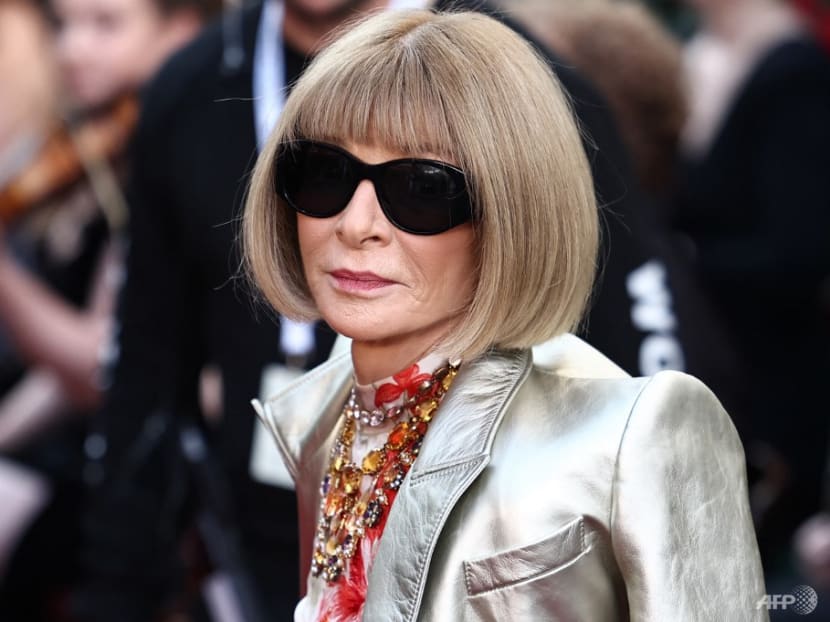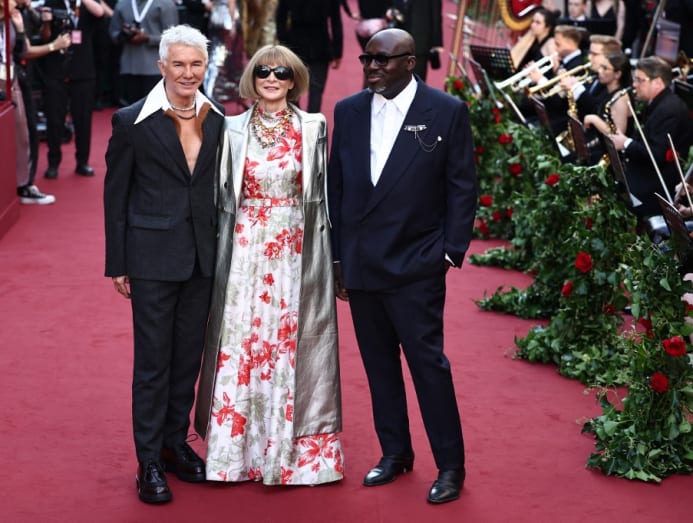Anna Wintour: ‘I just have to make sure things are being done right’
Vogue’s global editorial director on her rise to the top of the fashion world – and what she makes of her tough image.

Vogue editor-in-chief Anna Wintour. (Photo: AFP/Henry Nicholls)
Anna Wintour would like us to meet for lunch at The Ritz London, but when I inquire about a table for an FT interview, the restaurant turns me down. A call from one of Wintour’s two personal assistants later, and the receptionist emails to apologise: “I was not aware you were attending with Anna Wintour.”
Yielding unprocurable tables must be one of the many perks of being Vogue’s longstanding editor-in-chief and the inspiration for Meryl Streep’s imperious, fur-swathed lead in the 2006 film adaptation of The Devil Wears Prada.
Wintour has presided over the so-called fashion bible for 35 years, her celebrity and influence only increasing as the power of magazines and the Vogue brand have waned. In 2020, only months after rumours that she would soon step down amid accusations of racial bias – she apologised for her “mistakes” – she was promoted to global editorial director of Vogue and global chief content officer of Conde Nast, a role that has given her oversight of all Conde Nast magazines across 32 markets (minus The New Yorker).
I arrive 15 minutes early to an empty restaurant and am led to a semi-private room at the back. It is an old-fashioned space of pink-and-green trellis carpet and French ormolu, half-concealed by heavy brocade curtains. Just as I have placed my handbag on the proffered footstool, a black-suited waiter appears and informs me I am sitting in Anna’s preferred seat, will I please move to the other? “It’s best if these things start off smoothly,” he warns.
Are all The Ritz’s VIP guests treated this way? I rather doubt it. There is a mythos surrounding the 73-year-old editrix that inspires deference akin to that given to royalty. She has been likened to the Sun King, commanding total obsequience from her courtiers in the fashion domain; more recently, she has drawn comparisons to the late Queen Elizabeth II, empress of a diminishing empire. But surely the Queen, in her pastel suits and demure ropes of pearls, never inspired such terror?

Wintour arrives, smiling, and informs me that she doesn’t want to eat. “I find it quite difficult to eat and to be interviewed, so I think I’ll wait, but please order something.”
I wonder if I should explain the format of a Lunch with the FT, but decide against it. I order the first item I see on the vegan menu: A gnocchi dish. A waiter pours from a bottle of San Pellegrino into Wintour’s long-stemmed glass.
September is Wintour’s month. We’re part way through the international fashion weeks, and she has just held her first Vogue World show in London – a half-hour performance mixing theatre, opera, Annie Lennox and a multi-brand catwalk with Cindy Crawford, Christy Turlington, Naomi Campbell and Linda Evangelista.
Wintour is about to announce that a longtime member of her staff, Vogue.com editor Chioma Nnadi, will be replacing Edward Enninful at the helm of British Vogue. For six years he had positioned himself as the heir apparent to Wintour’s American throne, but she shows no signs of being willing to relinquish it. “I love what I do,” she says. “I am consistently challenged by it.”
Nnadi will assume the title not of editor-in-chief but head of editorial content. Since Wintour’s promotion in 2020, she and Conde Nast have replaced high-profile editors such as Vogue Paris’ Emmanuelle Alt and Vogue Italia’s Emanuele Farneti with younger, less costly talents who have not been given the same illustrious titles as their predecessors (Vogue China’s Margaret Zhang is the exception). The idea, says Wintour, is to “make sure everyone felt it was a different day, and that we were all working together as a global network”.
With hires, Wintour says she has “one rule: someone I am pleased to see when I see them in my office or if I bump into them in the street”.
Wintour is wearing a long, close-fitting dress of burgundy and navy floral lace from the Italian brand Marni; strings of pink and amethyst-coloured stones twinkle at her throat.

Although the room is dimly lit, she keeps her black Chanel sunglasses on; a member of her family once told me they are prescription glasses, and she can’t see well without them. She smiles often and laughs easily, but the sunglasses are a two-way shield from eye contact.
This is not my first opportunity to observe Wintour. I interned at American Vogue in early 2008, not long after Vogue published what was then its biggest September issue ever – 840 pages, of which 727 were ads – and which became the subject of an enormously popular documentary by RJ Cutler.
Conde Nast was then at the peak of its financial and reputational powers. Editors were chauffeured into work, some from as far as Connecticut, in black town cars (even as an intern, I had regular access to one). Their table placements at Conde Nast’s annual holiday party were the subject of obsessive coverage in the New York Post and a new gossip site called Gawker. Lehman Brothers would file for bankruptcy later that year, and the magazine industry would never recover.
A hush would descend when Wintour stepped into the lobby of Conde Nast’s then headquarters at 4 Times Square. On my first day, I was warned by a fellow intern never to make eye contact.
Years later, I returned to Conde Nast, then to its international headquarters in London, to start Vogue Business, which was launched in early 2019 without Wintour’s involvement or approval.
The waiter returns to refill her San Pellegrino. She tells him he can remove her plate.

Wintour came of age in late 1960s in London – amid Beatlemania, The Rolling Stones, and the thigh-baring skirts of Mary Quant. “I grew up at a time when women still left the dinner table so men could smoke their cigars and talk about the real issues of the day,” she says.
Hers was a privileged childhood, with a house on Phillimore Gardens, near Holland Park, now one of London’s most expensive streets (last year the average house price was £23.8m (S$39.7m)). Her mother was a film critic and her father the editor of the Evening Standard, where his exacting manner earned him the nickname “Chilly Charlie”. It is a characterisation that Wintour rejects.
“He was not a critical person. I would hear lots of stories about what a strong presence he was in the office, but we never saw that at home. He was very loving and kind and just wanted us to make our own way.”
Yet it was her father who suggested that Wintour write “editor of Vogue” on a careers form at school. “I don’t think I would have thought about it without him being so...specific.”
The seed might have been planted early, but Wintour’s journey to the top of the masthead was not a straight climb. She left school at 16. “I wasn’t very good at it, to be honest,” she says. “And wanted to be independent and make my own way.” Her phone begins to hum on silent, but she ignores it. “It was a combination of being a lazy student and having brothers and sisters who were very academic.”
She took up jobs on the sales floors of Biba, then Harrods. Her father helped her land her first editorial job at the fashion title Harper’s & Queen, where she impressed the staff with her designer clothes and immaculate grooming. Then, in her mid-twenties, she moved to New York, where she revelled in an anonymity she couldn’t have as the daughter of a famous newspaper editor in London: “Nobody gives a damn about where you come from or where you went to school.”
A stint at Harper’s Bazaar preceded a move to New York magazine, where she once persuaded Jean-Michel Basquiat to make a painting for a fashion shoot. Among those who took notice was Alexander Liberman, Conde Nast’s brilliant but wily editorial director, who called Wintour “a couple of times before he came up with a role that was the right fit”.
That role was creative director of Vogue, a job that did not previously exist and, much to the annoyance and alarm of then Vogue editor Grace Mirabella, reported not to her but to Liberman.
From Liberman, Wintour learnt “to keep meetings very short. He was very, very decisive. He understood creativity, he nurtured it, he valued it and he was also excellent at separating his private personal life [from] his work life.” He had, she recalls laughingly, “a desk with nothing on it, except I learnt later, a buzzer underneath, so that when he was done with you, which was in about five minutes, his assistant could come in and whisk you away.”
The waiter returns with a modest portion of gnocchi, which is left cooling on the table.
In 1985 Liberman and Conde Nast’s owner, Si Newhouse, sent her back to London to edit British Vogue. It was there – after she fired most of the staff – that Fleet Street began to paint her as an ice queen.
Wintour says she has done her best to ignore the tabloid caricatures. “They have a vivid imagination at times. I hope sincerely that the colleagues I work with know who I am and what our joint values are. I certainly know very well [my son] Charlie and [my daughter] Bee have a very clear idea of what I am and what I am not,” she says with a gentle laugh.
As her profile grew did she feel the need, as her late friend Karl Lagerfeld did, to develop a separate public persona?
Wintour, who utters not a single “um” during our interview, takes a long pause. “Karl was really good at separating his public persona from his private person. Sadly, I think he was quite, in many ways, solitary. And it’s not that he didn’t have close friends, he certainly did. But his private life, a lot of it, was connected to . . .” She leaves the word “work” unsaid.
“For me, when I’m home with my kids and the grandchildren and my friends at home, we don’t talk about work. We play tennis, and stupid games. That’s my solace.”

Wintour’s return to London was challenging in other ways. “My husband was chief of child psychiatry at Columbia, and he quite rightly didn’t want to give up his position. So we commuted quite a bit,” she recalls. “I had my son Charlie, and then I was pregnant with my daughter, so I felt like I was just endlessly pregnant . . . Eventually it seemed to me that staying in London long-term wasn’t going to be viable.”
She came back to New York to edit House & Garden for a few months before Newhouse offered her the job her father had chosen for her all those years ago. Mirabella learnt on a TV news programme that she’d been fired.
I take a bite of gnocchi, which is now tepid but surprisingly creamy and delicious, and press unsuccessfully for more details.
Wintour’s first cover in November 1988 set a new tone for Vogue – and also more broadly for fashion. Model Michaela Bercu was photographed on the street smiling and natural, her eyes half-closed, dressed in a Christian Lacroix top and her own jeans in a mix that would come to be known as “high/low”. It was a departure from the artificial, studio-shot covers of Vogues past.
In spite of her growing celebrity, Wintour’s position wasn’t always secure. In the wake of the 1990 recession, Vogue’s ad pages fell while those at rivals Harper’s Bazaar and Elle increased. Newhouse advised Wintour, who was sometimes reticent about featuring advertisers’ product in her pages, to “follow the money”. And she did.
Reports that she would be imminently stepping down from Vogue appeared in the press from time to time, reaching a peak in 2018, and again during the Black Lives Matters protests in 2020. Both times she emerged with a promotion: first as artistic director of Conde Nast, which gave her oversight of the publisher’s US titles (except for The New Yorker and Vanity Fair), and later as global editorial director of Vogue and chief content officer of Conde Nast.
It is probable that Conde Nast cannot afford to lose her. Advertisers run ads in Vogue not only because they think that will sell clothes, but also to secure Wintour’s favour and advice. She is frequently consulted by investors looking for young labels to back and executives in search of a new creative director.
When longtime Vogue photographer Annie Leibovitz was facing bankruptcy in 2009, Wintour found her a backer; she is also said to have helped secure the designer John Galliano, who was dismissed from Dior in 2011 after making antisemitic remarks in a widely circulated video, a job at Maison Margiela in 2014.
Then there are other sales-bolstering initiatives such as the Vogue 100, a club whose members pay US$100,000 (S$136,820) a year for access to Wintour and Vogue-organised events.
Delegation is not among Wintour’s managerial talents. She is notorious for controlling every last detail of the Met Gala down to the table placements and ingredients on the menu. How has she reconciled that with her expanding duties? “God is in the details,” she replies. “But I am not a creative person. I can’t draw, I can’t sketch, I can’t make anything. I just have to make sure things are being done right.”
A rigid schedule helps. She rises early, spends an hour at the gym and arrives at the office most mornings by 8:30. She says she always leaves the office at a “reasonable hour” – early enough for the theatre or a private screening at the cinema. Weekends are spent at her vast farmhouse-style compound at Mastic in Long Island, with her children and three grandchildren. Part of what she wanted from the house, she once told the FT, was a place to store her collections.
“I collect all kinds of china and pottery,” she says, lighting up as she mentions British makers such as Clarice Cliff, Susie Cooper and Quentin Bell.
I ask if she has read the biography Amy Odell published about her last year. She did not grant Odell an interview, but also did not discourage her friends and colleagues from speaking to Odell. She looks at me as she takes a long sip of San Pellegrino. “I haven’t read it.”
It’s been nearly 90 minutes, and Wintour has another meeting. I apologise that she hasn’t eaten lunch. “That’s OK,” she says, standing up as the waiter pulls back her chair. “I had a big breakfast.”
Lauren Indvik © 2023 The Financial Times













